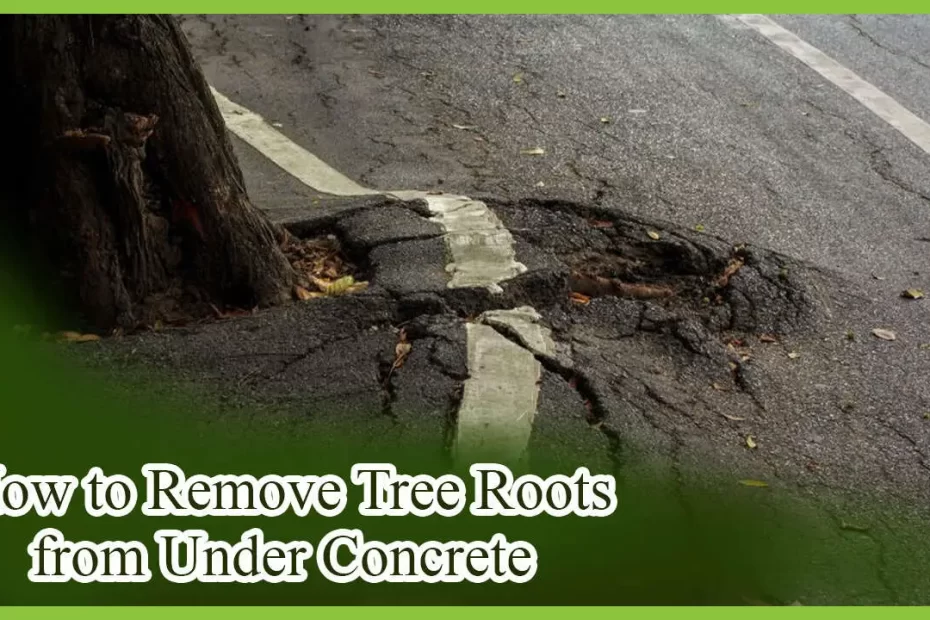Unbeknownst to many, beneath our steadfast concrete structures lies a world of hidden power and resilience. Yes, we’re talking about those relentless tree roots, navigating their way like underground pioneers, exerting their force and sometimes causing chaos. If you’ve ever encountered the temerity of tree roots sprouting under your precious concrete sanctuary, fear not, for we have arrived with a guide to liberate your foundation from these determined intruders. Prepare to embark on an odyssey where concrete battles nature, as we unveil the secrets on how to remove tree roots from under concrete.
Understanding the issue: Tree roots and their impact on concrete structures
One common problem faced by homeowners is the impact of tree roots on concrete structures. These intrusive roots can wreak havoc, causing cracks, upheaval, and even structural damage. Understanding the issue and finding effective ways to remove tree roots from under concrete is crucial to maintaining the integrity of your property.
When dealing with tree roots under concrete, it’s important to approach the problem systematically. First, identify the problematic areas where the roots are causing damage. This can be done by inspecting the concrete for cracks, depressions, or signs of uplifting. Once identified, you can proceed with the following methods to safely remove the tree roots:
1. Utilize chemical root killers: There are various root-killing products available in the market that can be applied directly to the roots. These chemicals penetrate the roots and prevent them from growing further, ultimately killing them off. However, it’s essential to follow the manufacturer’s instructions and take appropriate safety precautions when using such chemicals.
2. Cut and remove the roots: Another effective method is to physically cut and remove the tree roots. This can be done by carefully digging around the affected area and locating the roots. Use a sharp saw or pruners to cut the roots, making sure not to damage the concrete in the process. Once cut, carefully remove the severed roots and fill the area with soil or concrete.
In the table below, you’ll find additional features or tips to consider when removing tree roots from under concrete:
| Features/Tips | Benefits |
|---|---|
| Professional assistance | Seeking help from a certified arborist or tree removal service can ensure the safe removal of roots without causing further damage. |
| Regular maintenance | Conducting regular inspections and maintenance can help identify and address root-related issues before they escalate. |
| Installing root barriers | Installing physical root barriers during construction or landscape planning can help prevent future root intrusion into concrete structures. |
Understanding the impact of tree roots on concrete structures is essential for any homeowner. By employing the right methods and taking necessary precautions, you can effectively remove tree roots from under concrete, maintaining the longevity and safety of your property. Remember to prioritize safety and consult professionals when needed to ensure the best possible outcome.

Assessment and analysis: Identifying the extent of damage and root system invasion
When it comes to removing tree roots from under concrete, a crucial first step is conducting a thorough assessment and analysis to determine the extent of damage and the level of root system invasion. It’s essential to understand the problem to implement an effective solution. By accurately identifying the damage and invasion, you can devise a plan that ensures the removal process is targeted, minimizing any potential further complications.
One way to assess the damage is to visually inspect the concrete for any cracks or heaving caused by the tree roots. Additionally, it’s important to evaluate if the roots have reached and damaged any utility lines or pipes beneath the concrete. These findings will provide valuable insight into the scope of the problem, enabling you to take appropriate measures.
Features and Tips:
| Feature/Tips | Benefits |
|---|---|
| Prioritize professional arborist assessment | Expert evaluation ensures accurate identification of root invasion extent and potential risks. |
| Consider non-destructive removal techniques | Minimizes structural damage and reduces the need for extensive repairs. |
| Utilize appropriate tools and protective gear | Enhances safety and efficiency during the root removal process. |

Effective removal methods: Exploring strategies for safely and efficiently removing tree roots from under concrete
When it comes to removing tree roots from under concrete, it is essential to have an effective and strategic approach. These stubborn roots can cause significant damage over time, leading to costly repairs if not addressed promptly. In this post, we will explore various strategies that are both safe and efficient in tackling this common problem.
<h2>Exploring Different Methods</h2>
<p>1. <strong>Chemical treatments:</strong> One popular option is to use specially formulated chemicals that help weaken and decay the tree roots over time, making them easier to remove. However, it's important to follow the manufacturer's instructions carefully and ensure the chemicals are safe for the surrounding environment.</p>
<p>2. <strong>Physical removal:</strong> For smaller roots, manual extraction can be an effective method. It involves using hand tools such as a shovel or mattock to dig around the root and carefully dislodge it from the concrete. This method requires patience and precision.</p>
<p>3. <strong>Mechanical assistance:</strong> In cases where the tree roots are larger or deeply embedded, mechanical equipment like a root grinder can be utilized. A root grinder uses rotating blades to cut through the roots, allowing for easier and faster removal. However, it's crucial to exercise caution and <a href="https://up-gardening.com/how-to-build-a-tree-ring-on-a-slope/" title="How to Build a Tree Ring on a Slope">seek professional guidance</a> when operating heavy machinery.</p>
<p>4. <strong>Preventive measures:</strong> After successfully removing the tree roots, it's crucial to take preventative steps to avoid future issues. Installing a root barrier, like a physical barrier or chemical deterrent, can deter roots from growing towards the concrete area and causing damage. Regularly maintaining trees and trimming their roots can also prevent future root intrusion.</p>
<table>
<tr>
<th>Features/Tips</th>
<th>Benefits</th>
</tr>
<tr>
<td>1. Use protective gear</td>
<td>Ensures personal safety during the removal process</td>
</tr>
<tr>
<td>2. Assess root size and depth</td>
<td>Determines the most appropriate removal method</td>
</tr>
<tr>
<td>3. Consult a professional</td>
<td>Expert guidance can prevent accidental damage and ensure effective removal</td>
</tr>
</table>
Prevention and maintenance: Maintaining root-free concrete areas to prevent future damage
Concrete areas can provide a sturdy and long-lasting foundation for various structures. However, when tree roots start infiltrating the concrete, it can lead to costly damage and structural issues. To prevent future damage and maintain root-free concrete areas, it’s important to take proactive measures. Here are some effective methods to remove tree roots from under concrete and ensure the longevity of your concrete surfaces.
Cutting and removal: One approach is to cut the tree roots that have infiltrated the concrete and remove them completely. This involves carefully excavating the area around the affected concrete surface, identifying the root system, and using appropriate tools to slice through the roots without causing further damage. Once the roots are cut, they can be pulled out and disposed of properly to prevent re-growth.
Applying root inhibitors: Another method is to use root inhibitors, which are chemical substances designed to discourage root growth. These inhibitors can be applied directly to the soil surrounding the concrete area, forming a barrier that discourages root growth towards the concrete. It’s important to carefully follow the product instructions and use the appropriate amount to effectively inhibit root growth while minimizing any potential harm to other plants nearby.
In addition to these methods, there are various features and tips that can help in maintaining root-free concrete areas. Here are some examples:
| Feature/Tips | Benefits |
|---|---|
| Regular inspection | Allows early detection of root infiltration and appropriate action can be taken promptly. |
| Proper drainage | Adequate drainage can prevent excess moisture which can attract root growth. |
| Installing root barriers | Physical barriers such as metal sheets or plastic can prevent root penetration into the concrete area. |
By implementing these methods and following the recommended features and tips, you can successfully remove tree roots from under concrete and maintain root-free areas. Taking proactive measures will not only protect your concrete surfaces but also save you from costly repairs and ensure the longevity of your structures.
Frequently Asked Questions
Q: Can tree roots really cause cracks in concrete?
A: Ah, yes, those sneaky tree roots! They possess the incredible ability to cause juicy cracks in concrete pathways. Watch out, folks!
Q: What is the most creative way to remove tree roots from under concrete?
A: Ready for some arts and crafts? How about using a magic wand to zap those pesky roots away? Just kidding! Unfortunately, creativity won’t cut it here. We’ll need some serious digging and cutting tools to free your concrete from the clutches of these stubborn roots!
Q: Is there any way to prevent tree roots from wreaking havoc on my concrete?
A: Wishful thinking won’t do the trick, my friend. But fear not! Installing root barriers during the concrete construction process can be a knight in shining armor! These barriers will help keep tree roots at bay, ensuring harmony between your trees and concrete for years to come. As we bid farewell to these stubborn tree roots that dared to challenge the unyielding strength of concrete, I hope we have unearthed some valuable knowledge together. It is no small feat to overcome nature’s tenacity and restore the balance between man-made structures and the organic wonder of trees. Remember, wielding the tools of patience, perseverance, and precision, you can conquer even the most intricate root systems hidden beneath the sturdy surface of concrete. By following these steps, you will not only free your property from the grip of invasive roots but also ensure its longevity and harmony for generations to come. So, go forth, fellow adventurers, armed with your newfound understanding of the underground realm, and let nothing deter you from your mission to reclaim control over your concrete kingdom. Faced with the formidable task of removing tree roots, you can now embrace it with confidence and grace, leaving behind a legacy of triumph over nature’s quiet rebellion.
- When to Put Weed and Feed on Lawn in Michigan - October 16, 2023
- When to Fertilize Potatoes Plants - October 16, 2023
- Can You Plant Clover in the Spring - October 16, 2023
Contents
- 1 Understanding the issue: Tree roots and their impact on concrete structures
- 2 Assessment and analysis: Identifying the extent of damage and root system invasion
- 3 Effective removal methods: Exploring strategies for safely and efficiently removing tree roots from under concrete
- 4 Prevention and maintenance: Maintaining root-free concrete areas to prevent future damage
- 5 Frequently Asked Questions

